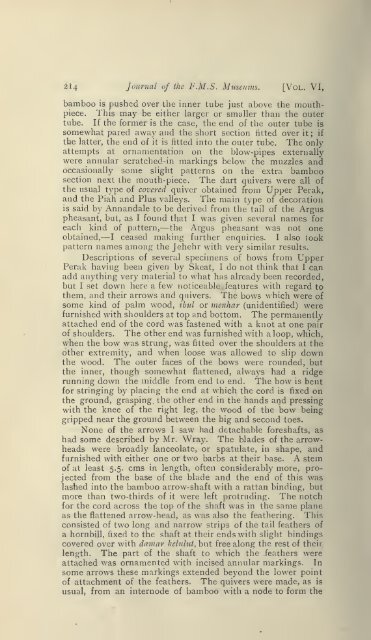Journal of the Federated Malay States museums - Sabrizain.org
Journal of the Federated Malay States museums - Sabrizain.org
Journal of the Federated Malay States museums - Sabrizain.org
You also want an ePaper? Increase the reach of your titles
YUMPU automatically turns print PDFs into web optimized ePapers that Google loves.
:2l4 journal <strong>of</strong> <strong>the</strong> F.M.S. Museums. [Vol. VI,<br />
bamboo is pushed over <strong>the</strong> inner tube just above <strong>the</strong> mouthpiece.<br />
This may be ei<strong>the</strong>r larger or smaller than <strong>the</strong> outer<br />
tube. If <strong>the</strong> former is <strong>the</strong> case, <strong>the</strong> end <strong>of</strong> <strong>the</strong> outer tube is<br />
somewhat pared away and <strong>the</strong> short section fitted over it ; if<br />
<strong>the</strong> latter, <strong>the</strong> end <strong>of</strong> it is fitted into <strong>the</strong> outer tube. The only<br />
attempts at ornamentation on <strong>the</strong> blow-pipes externally<br />
were annular scratched-in markings below <strong>the</strong> muzzles and<br />
occasionally some slight patterns on <strong>the</strong> extra bamboo<br />
section next <strong>the</strong> mouth-piece. The dart quivers were all <strong>of</strong><br />
<strong>the</strong> usual type <strong>of</strong> covered quiver obtained from Upper Perak,<br />
and <strong>the</strong> Piah and Plus valleys. The main type <strong>of</strong> decoration<br />
is said by Annandale to be derived from <strong>the</strong> tail <strong>of</strong> <strong>the</strong> Argus<br />
pheasant, but, as I found that I was given several names for<br />
each kind <strong>of</strong> pattern,—<strong>the</strong> Argus pheasant was not one<br />
obtained,— I ceased making fur<strong>the</strong>r enquiries. I also took<br />
pattern names among <strong>the</strong> Jehehr with very similar results.<br />
Descriptions <strong>of</strong> several specimens <strong>of</strong> bows from Upper<br />
Perak having been given by Skeat, I do not think that I can<br />
add anything very material to what has already been recorded,<br />
but I set down here a few noticeable features with regard to<br />
<strong>the</strong>m, and <strong>the</strong>ir arrows and quivers. The bows which were <strong>of</strong><br />
some kind <strong>of</strong> palm wood, ibul or menhar (unidentified) were<br />
furnished with shoulders at top and bottom. The permanently<br />
attached end <strong>of</strong> <strong>the</strong> cord was fastened with a knot at one pair<br />
<strong>of</strong> shoulders. The o<strong>the</strong>r end was furnished with a loop, which,<br />
when <strong>the</strong> bow was strung, was fitted over <strong>the</strong> shoulders at <strong>the</strong><br />
o<strong>the</strong>r extremity, and when loose was allowed to slip down<br />
<strong>the</strong> wood. The outer faces <strong>of</strong> <strong>the</strong> bows were rounded, but<br />
<strong>the</strong> inner, though somewhat flattened, always had a ridge<br />
running down <strong>the</strong> middle from end to end. The bow is bent<br />
for stringing by placing <strong>the</strong> end at which <strong>the</strong> cord is fixed on<br />
<strong>the</strong> ground, grasping, <strong>the</strong> o<strong>the</strong>r end in <strong>the</strong> hands and pressing<br />
with <strong>the</strong> knee <strong>of</strong> <strong>the</strong> right leg, <strong>the</strong> wood <strong>of</strong> <strong>the</strong> bow being<br />
gripped near <strong>the</strong> ground between <strong>the</strong> big and second toes.<br />
None <strong>of</strong> <strong>the</strong> arrows I saw had detachable foreshafts, as<br />
had some described by Mr. Wray. The blades <strong>of</strong> <strong>the</strong> arrowheads<br />
were broadly lanceolate, or spatulate, in shape, and<br />
furnished with ei<strong>the</strong>r one or two barbs at <strong>the</strong>ir base. A stem<br />
<strong>of</strong> at least 5.5. cms in length, <strong>of</strong>ten considerably more, projected<br />
from <strong>the</strong> base <strong>of</strong> <strong>the</strong> blade and <strong>the</strong> end <strong>of</strong> this was<br />
lashed into <strong>the</strong> bamboo arrow-shaft with a rattan binding, but<br />
more than two-thirds <strong>of</strong> it were left protruding. The notch<br />
for <strong>the</strong> cord across <strong>the</strong> top <strong>of</strong> <strong>the</strong> shaft was in <strong>the</strong> same plane<br />
as <strong>the</strong> flattened arrow-head, as was also <strong>the</strong> fea<strong>the</strong>ring. This<br />
consisted <strong>of</strong> two long and narrow strips <strong>of</strong> <strong>the</strong> tail fea<strong>the</strong>rs <strong>of</strong><br />
a hornbill, fixed to <strong>the</strong> shaft at <strong>the</strong>ir ends with sliglit bindings<br />
covered over with damar kelnlut, but free along <strong>the</strong> rest <strong>of</strong> <strong>the</strong>ir<br />
length. The part <strong>of</strong> <strong>the</strong> shaft to which <strong>the</strong> fea<strong>the</strong>rs were<br />
attached was ornamented with incised annular markings. In<br />
some arrows <strong>the</strong>se markings extended beyond <strong>the</strong> lower point<br />
<strong>of</strong> attachment <strong>of</strong> <strong>the</strong> fea<strong>the</strong>rs. The quivers were made, as is<br />
usual, from an internode <strong>of</strong> bamboo with a node to form <strong>the</strong>

















